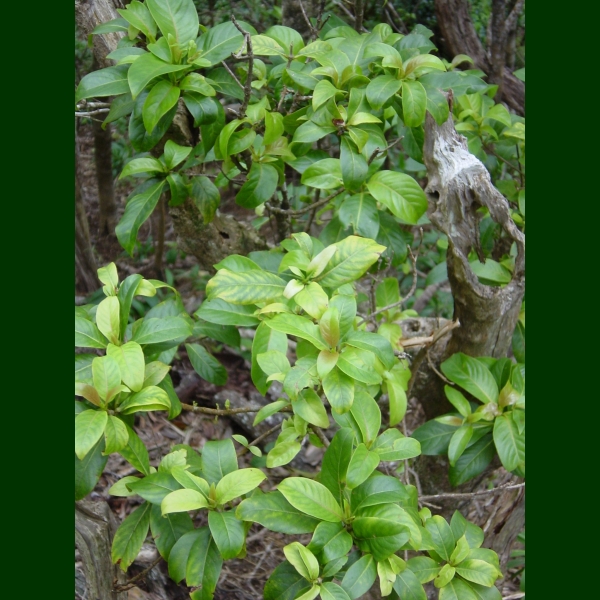 Hawaiian Name(s): ‘ahakea, ‘ahakea lau li‘i (B. brevipes), ‘akupa (B. brevipes), ‘ahakea lau nui (B. elatior)
Hawaiian Name(s): ‘ahakea, ‘ahakea lau li‘i (B. brevipes), ‘akupa (B. brevipes), ‘ahakea lau nui (B. elatior)Scientific Name: Bobea (4 species)
Vernacular Name: none
Family: Rubiaceae
Status: endemic
Authority: B. brevipes A.Gray, B. elatior Gaudich., B. sandwicensis (A.Gray) Hillebr., B. timonioides (Hook.f.) Hillebr.
Description: Trees, all 4 species up to 10 m tall, wood is a dull orange-brown & becomes dark gold when rubbed with kukui oil.
Habitat B. brevipes in mesic to wet forests from 250–1280 m (Kaua‘i and O‘ahu); B. elatior in mesic valleys to mesic to wet forests 250–100 m (Kaua‘i, Moloka‘i, Maui, Hawai‘i); B. sandwicensis in dry to mesic forest and open lava flows 100–1220 m (O‘ahu, Moloka‘i, Lana‘i, Maui); B. timoniodes dry to mesic forest 250–580 m on Maui and Hawai‘i (Wagner et al. 1990:1115–1118).
Medicines: In a treatment for abcesses ‘ahakea bark is ground with puakala ku kula root bark (Argemone glauca), ‘ohi‘a ‘ai bark (Syzygium malaccense), and ‘auko‘i (Senna occidentalis), and then placed in a mai‘a (banana, Musa spp.) and used as a poultice (Chun 1994:4–5).
Non Medicinal Uses: Yellow wood used for canoes; most favored for gunwales (Krauss 1993:50), poi pounding boards, canoe paddles (Malo 1951:20), and door and door–frames (Krauss 1993:57). In the Ethnology Collection at Bishop Museum there is a post-contact example of the wood made into a bowl.
Specific gravity of wood: unknown
Famous Locations:
Mele:
`Ōlelo Noeau: I ke aha ho‘i? I ka ‘ahakea! Why? The ‘ahakea! A saucy retort to the question "Why?" A play on aha (why) and ‘aha in the word ‘ahakea. The ‘ahakea is a native tree.
Dye Color and Parts:
Kino lau:
Location on Bishop Museum Kalihi Campus:
Propagation Information: Hawaiian Native Plant Propagation Database.
Seed: Seed length approximately 4 mm. Photograph: B.Kennedy. Species: B. elatior.

